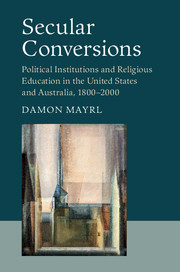 Secular Conversions
Secular Conversions from Part III - Forging the twentieth-century settlement
Published online by Cambridge University Press: 05 August 2016
INTRODUCTION
Between 1964 and 1973, the nineteenth-century settlement that banned “state aid” to Australia's religious schools collapsed. A series of federal and state initiatives extended a trickle, then a torrent, of money to Catholic and other religious schools. By 1974, state aid was an accepted part of the Australian educational landscape, formally institutionalized in a new Schools Commission that doled out aid to religious schools on a recurrent per capita basis. The reintroduction of state aid represents the creation of a new settlement decidedly less “secular” than the one that preceded it. Whereas the former had refused any supportive relationship between the state and the churches in education, the new one treated church and state as collaborative partners in educational endeavors, under the banner of “religious neutrality.”
Why was state aid reintroduced in Australia, but not the United States? As in the United States, Australia's new secular settlement emerged thanks to a shift in the dynamics of religious conflict, a coordinated campaign to realize a new secular settlement, and a set of political opportunities made possible by favorable institutional terrain. In Australia, Catholics led the campaign for the new settlement. The dynamics of religious conflict shifted in the 1960s as the longstanding conflict between Catholics and Protestants was replaced by an ecumenical spirit that greatly reduced Protestants’ incentives to oppose state aid. At the same time, a split in the Australian Labor Party (ALP) led to the creation of a new, predominantly Catholic political party. This effectively transformed Catholics into political free agents whose votes were highly sought after, giving them powerful new leverage in federal and state politics.
This unprecedented political opportunity emerged in large part thanks to Australia's electoral institutions. Australia's preference-voting rules produced a relatively flexible party system with real political space for third parties. Catholics took advantage of this flexibility to create their own party in the mid-1950s, and manipulated the features of the preference-voting system to enhance their political influence during the 1960s. The institutional availability of the legislative pathway can be seen when the Australian experience is contrasted with a parallel campaign by Catholics for public aid in the United States.
To save this book to your Kindle, first ensure [email protected] is added to your Approved Personal Document E-mail List under your Personal Document Settings on the Manage Your Content and Devices page of your Amazon account. Then enter the ‘name’ part of your Kindle email address below. Find out more about saving to your Kindle.
Note you can select to save to either the @free.kindle.com or @kindle.com variations. ‘@free.kindle.com’ emails are free but can only be saved to your device when it is connected to wi-fi. ‘@kindle.com’ emails can be delivered even when you are not connected to wi-fi, but note that service fees apply.
Find out more about the Kindle Personal Document Service.
To save content items to your account, please confirm that you agree to abide by our usage policies. If this is the first time you use this feature, you will be asked to authorise Cambridge Core to connect with your account. Find out more about saving content to Dropbox.
To save content items to your account, please confirm that you agree to abide by our usage policies. If this is the first time you use this feature, you will be asked to authorise Cambridge Core to connect with your account. Find out more about saving content to Google Drive.